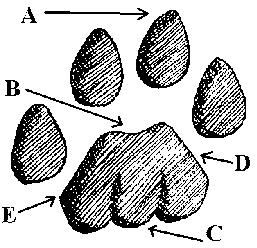

Domestic cat prints are smaller than bobcat and rounder than a canine print. Notice the arching curvature of the four toes above the palm pad. Observes need to gather multiple pieces of information to make an identification.įelines all have the patterns you see above: 4 toes, typically no toenail marks visible (claws are retracted), and a rounded shape. What is the overall shape? How many toes do you see? What is shape of the palm pad both at the leading and trailing sides? Do you see townail claw marks? Remember that conditions vary, so some traits will not be clearly visible. Compare how the print appears bigger in the mud on the right, compared to firmer soil on the left. Measure from the outer edges of both left and right prints.īutters, a 12-pound house cat, made both prints pictured above. Measure straddle- the side-to-side total width of the tracks- as this will tell you how far apart the shoulders are.However, this is harder to tell in our well-fed domesticated pets than in their wild relatives. Both cats and dogs carry more weight on the front of their bodies, and have larger front paws. Try to see if you can distinguish between front and rear paws.This will help you continue your study back at home. Take a close-up photograph of several tracks, and be sure to add an item that will help determine scale, such as a glove, pocket knife, or ski pole.Look at the perimeter outline shape of the large lower palm pad (also called heel pad). Count the number of toes, check for toenail marks, and look at the shape of each element.You will find a lot of variation so try to look at quite a few prints before you select one or two to study closely.

The pattern of movement will tell you a story about the animal’s behavior.

Carry a small ruler so you can measure the length and width of a print and the distance between sets of prints. Tracking books include precise measurements. Purchasing one of the excellent field guides shown will provide critical guidance and tips. Let’s get started with identifying the tracks of domestic cats and dogs. Look farther down for some useful identification tips.These are two excellent field guides to carry with you in a backpack It’s contributed a lot to our understanding of these animals.”īorrowing on her theme and using pictures from our cache, the Wisconsin and Minnesota Departments of Natural Resources, and photos recently submitted by readers, below are a few pics to test your skills. “Most of the time they’re bobcats and housecats, but every now and then we get an actual photo of a mountain lion, which is great. “It was something fun to do with all these pictures we receive of possible mountain lion sightings,” LaRue said. Each Friday at 11:30 a.m., a picture is posted. Michelle LaRue, a research associate at the University of Minnesota and executive director of The Cougar Network, puts on a weekly social media quiz: #CougarOrNot. State wildlife officials believe one widely shared 2016 sighting of a pair of cougars fighting in northern Minnesota was mistaken identity, and they were probably bobcats. Can you tell the difference between a cougar, or mountain lion, and a bobcat (or even a house cat)?


 0 kommentar(er)
0 kommentar(er)
